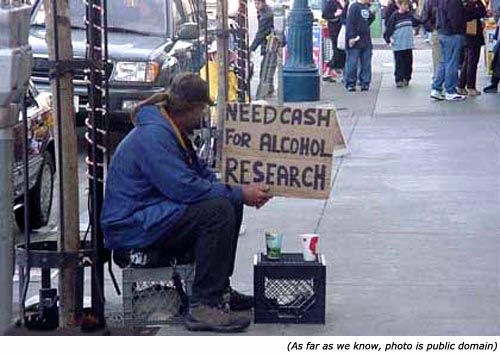Prevailing Medicine for Alcoholism
When the alcoholic accepts that the issue exists and agrees to quit drinking, treatment for alcoholism can begin. She or he must recognize that alcohol addiction is curable and must be driven to change. Treatment has 3 stages:

Detoxification (detox): This may be required as soon as possible after discontinuing alcohol use and could be a medical emergency, considering that detoxification can cause withdrawal seizures, hallucinations, delirium tremens (DT), and sometimes might lead to death.
Rehabilitation: This includes counseling and medicines to give the recovering alcoholic the skills needed for preserving sobriety. This phase in treatment can be done inpatient or outpatient. Both are just as effective.
Maintenance of abstinence: This step's success requires the alcoholic to be self-driven. The key to maintenance is support, which commonly includes routine Alcoholics Anonymous (AA) gatherings and getting a sponsor.
Recovery is http://ragingalcoholic.com/moderation-management/ often hard to sustain since detoxing does not stop the longing for alcohol. For an individual in an early stage of alcoholism, ceasing alcohol use might cause some withdrawal manifestations, consisting of stress and anxiety and poor sleep. Withdrawal from long-term dependency may induce unmanageable shaking, spasms, anxiety, and the hallucinations of DTs. If not remedied professionally, individuals with DTs have a mortality rate of over 10 %, so detoxification from late-stage alcoholism must be attempted under the care of a highly trained doctor and may mandate a short inpatient stay at a healthcare facility or treatment center.
Treatment methods might include one or more pharmaceuticals. These are the most regularly used medicines throughout the detoxing stage, at which time they are normally tapered and then ceased.
There are a number of medications used to help people in rehabilitation from alcohol dependence maintain abstinence and sobriety. It interferes with alcohol metabolism so that consuming alcohol even a small amount is going to induce nausea, retching, blurred vision, confusion, and breathing troubles.
Yet another medicine, naltrexone, lowers the longing for alcohol. Naltrexone can be supplied even if the individual is still drinking; however, just like all medications used to address alcoholism, it is advised as part of a detailed program that teaches patients new coping skills. It is currently offered as a controlled release inoculation that can be given on a regular monthly basis.
Acamprosate is yet another medication that has been FDA-approved to minimize alcohol craving.
Lastly, research indicates that the anti-seizure medications topiramate and gabapentin may be useful in minimizing craving or anxiety during rehabilitation from alcohol consumption, even though neither of these medications is FDA-approved for the treatment of alcohol addiction.
medicationsAnti-anxietyor Anti-depressants medications might be used to control any resulting or underlying stress and anxiety or melancholy, but since those symptoms might disappear with abstinence, the medications are generally not http://ragingalcoholic.com/driving-high/ begun until after detoxing is complete and there has been some time of sobriety.

Because an alcoholic remains susceptible to relapse and possibly becoming dependent anew, the goal of recovery is overall sobriety. Recovery normally takes a Gestalt strategy, which may include education and learning programs, group treatment, family members participation, and participation in support groups. Alcoholics Anonymous (AA) is the most well known of the support groups, however other methods have also proved profitable.
Diet and Nutrition for Alcoholism
Substandard nutrition goes along with heavy drinking and alcohol dependence: Since an ounce of ethyl alcohol (the kind we drink) has over 200 calories but zero nutritional benefit, ingesting substantial amounts of alcohol tells the human body that it doesn't need additional food. Problem drinkers are often lacking in vitamins A, B complex, and C; folic acid; carnitine; selenium, zinc, and magnesium, in addition to essential fatty acids and antioxidants. Strengthening such nutrients-- by supplying thiamine (vitamin B-1) and a multivitamin-- can aid recovery and are an important part of all detox protocols.
Home Treatments for Alcohol addiction
Sobriety is one of the most essential-- and probably one of the most hard-- steps to rehabilitation from alcohol dependence. To discover how to live without alcohol, you should:
Stay away from people and places that make consuming alcohol the norm, and discover new, non-drinking acquaintances.
Join a self-help group.
Get the help of friends and family.
Change your negative dependence on alcohol with favorable dependencies like a brand-new hobby or volunteer work with church or civic groups.
Start exercising. Physical exertion releases neurotransmitters in the human brain that supply a "all-natural high." Even a walk following supper can be tranquilizing.
Treatment methods for alcohol addiction can begin only when the alcoholic acknowledges that the issue exists and agrees to stop consuming alcohol. For an individual in an early phase of alcohol addiction, ceasing alcohol use might result in some withdrawal manifestations, consisting of anxiety and poor sleep. If not addressed appropriately, individuals with DTs have a mortality rate of over 10 %, so detoxing from late-stage alcohol dependence ought to be tried under the care of a skilled http://dictionary.reference.com/browse/alcoholism?s=t physician and may necessitate a short inpatient stay at a hospital or treatment facility.
There are numerous medicines used to assist people in rehabilitation from alcohol dependence maintain sobriety and abstinence. Poor nutrition goes with heavy alcohol consumption and alcohol dependence: Because an ounce of alcohol has over 200 calories but no nutritionary value, ingesting big levels of alcohol informs the body that it doesn't require additional nourishment.

